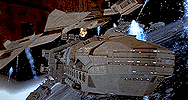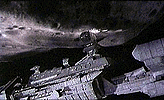


The Space Sequences: Above and Beyond
"The space sequences of TROOPERS... pound through cliche to provide some stunning, never-before-seen scenarios."
As supervised by Scott E. Anderson, the space sequences fall into a few major categories: the Fleet, the asteroid grazing sequence, the Lunar Space Ring sequence and the Ticonderoga sequences.
The Fleet
The lion's share of Fleet sequences were handled by Sony Pictures Imageworks, and they contain some of the most dazzling space battle shots in recent memory. The plasma blasts that eminate from the planet's surface shimmer against the sides of the ships,
Dropships are released by the RY class ships and fly through the planet's atmosphere, landing on the surface to allow the mobile infantry to fight their battles. Some of the shots of Dropships battling the atmospheric conditions contain some realistic camera shake, shake that is absolutely necessary to maintain the illusion that a 'camera ship' is actually photographing the elements in front of it.
A terrific, subtle transition occurs as the camera, lying on the planet's surface, tracks a ship swerving around its position and landing. Within the same shot, the gantry opens and dozens of soldiers march out. It's a terrific bait-and-switch--the audience's suspension of belief is solidified as a typical 'special effects' shot looks convincingly like something that actually happened right in front of the camera.
Adding to the believability of the Fleet sequences are the engine's heat distortion "Particularly commendable in the design of the Fleet shots was giving the sense of spontaneity in the photography of the ships."
Particularly commendable in the design of the Fleet shots was giving the sense of spontaneity in the photography of the ships. One such example occurs as the camera focuses on four or five plasma streams rising from the planet. The camera whip pans to follow the streams, and as it concludes its 180 degree turn, resting on the Fleet and the plasma streams hitting ships, the camera does a subtle yet highly effective adjustment--as if the 'cameraman,' whipped the camera too far, and then adjusted to frame the action. This small feature created for this shot lends a great deal to the believability of the sequence. The shot mirrors documentary and news footage, where the cameraman is constantly readjusting the framing of the shot. So many times in space visual effects sequences, the camera is robotic, anticipating the action that 'occurs' in front of the camera.
As the escape pods travel to the planet's surface, following the dramatic destruction of the Rodger Young, a series of shots taken from the inside of an escape pod chronicle their descent through the atmosphere. Unfortunately, these interior 'windshield' shots, along with many others in the film, were executed using a technique that I feel reduces the illusion of the shot.
During Hollywood car chases, when a director wishes to photograph the driver, a camera is mounted inside the car to film the actor, as well as capture the background action whizzing by. In STARSHIP TROOPERS, a camera is placed within the cockpit of a spacecraft, in order to film the pilot, as well as the space action occurring beyond the windshield. But instead of the camera being mounted on the dashboard of the ship, STARSHIP TROOPERS' camera is floating, seemingly independent of the ship's motion and the background. In some shots, the interior element (the actors and the cockpit) makes violent movements, while the background (starfield, ships, explosions) does not match the movement of the ship. These scenes would have been a lot more effective if the camera wasn't floating within the ship, but locked down, attached to the ship. This setup would have required a great deal more attention to 2D motion tracking of the starfield and space elements, but the final result would have been less awkward.
Asteroid Grazing Sequence
The scene is quite different from just about every other space sequence in the film, in that only two major models populate space at any one time - the ship and the asteroid. As the asteroid slowly rotates toward the ship, its huge scale is accurately portrayed (due to its exceptional stage lighting), and the Rodger Young's quick response to the asteroid is portrayed with an equal amount of interesting detail and believable choreography. Especially interesting is the subtle trail of debris that the RY trails into space. Especially awkward is the compositing of a particular explosion element when the asteroid hits the RY--the pyro element seemed completely unmotivated and out of scale.
The great deal of interior greenscreen compositing, even through violent camera shakes (especially one particular steadicam shot, when the captain appears on the bridge), is consistent and believable.
The sequence begins with a dramatic crane down, starting as a wide shot of the RY, and closing in on the cockpit of the craft. The shot is staggeringly complicated, with a portion of the model dissolving to a CG version, which is composited with the live-action footage. These transitions occur invisibly - the audience-at-large will never realize the various stages of this highly complicated shot. Unfortunately, the shot's design is what makes it awkward--the movement of the camera is far too extreme, relative to the calm, almost sedate camera movements of other space shots, making the shot stick out and call attention to itself.
Lunar Space Ring & Ticonderoga
The best thing about the sequence is the spontanteous feeling of the camera moves. The camera isn't the least bit robotic in these sequences. The models, especially the lunar ring (which must have been absolutely huge), have a lot of detail and were photographed quite nicely. The cockpit shots suffer from the same problem as do the lifeboat shots, in that the camera is floating, and the background action doesn't necessarily match the ship's movements.
The space excellence continues with the sequences surrounding the Ticonderoga space station. The first of which reveals the station for the first time and docking RY class ships, wholly constructed as model miniatures. The second time we see the station is when it is populated with highly damaged ships, returning from the film's first space slaughter. The damaged ships are extraordinarily detailed, as is the station itself. The Ticonderoga and Lunar Ring sequences were created, shot and composited by Industrial Light & Magic.
Also handled by ILM is the film's introductory shots of an asteroid zooming its way towards earth, and its destruction via Federation blasters. The crisp and interesting sequence ends with the asteroid's explosion, which looks eerily similar to ILM's destruction of the Borg sphere in STAR TREK: FIRST CONTACT.
No good science fiction film can exist without convincing space sequences. Ships flying in and out of danger, enormous waves of plasma fire from Plasma bugs, drop ships blasting through the atmosphere... these are just a few scenarios of STARSHIP TROOPERS' space sequences.
Over the past thirty years, sci-fi fans have been treated to dozens of spaceship films, the most notable include 2001, STAR WARS and APOLLO 13. The space sequences of TROOPERS tread similar ground, and yet pound through cliche to provide some stunning, never-before-seen scenarios and space action.
The massive ships that are the strength of the Fleet move through space with elegance and power. While smaller dropships and transfer vehicles zip through the air with dazzling moves, the larger ships lumber into slow rolls and turtle-speed maneuvers. The ships contain a huge amount of detail, all of which add to the effect of size. The vehicles truly seem massive.
with accurate interactive lighting. When a blast rips the Rodger Young in half, the massive scale of the ship is evident in its slow separation. The best shots of the Fleet sequences are subsequent shots of the RY, in half and on fire. Each deck of the ship's torn midsection contains its own fiery blaze, complete with interactive lighting on each deck, contributing to the illusion of its enormous scale. Hundreds of pyrotechnic elements were composited quite well into these sequences.

The Rodger Young weaves its way through disabled Fleet starships.
patterns, achieved via a combination of model lighting and CG elements composited over the miniatures. With as many as 50 ships populating the screen at any one time, the engine distortion helped sell the illusion of this massive fleet in space.
As the Rodger Young travels through space, an unexpected present is handed to them--an asteroid headed straight for them. With quick reflexes, the ship is able to avert the asteroid's path with only minimal damage. The visual effects elements were created
and shot by Boss Film Studios, and composited by POP Film.

The Rodger Young gets nailed by the looming asteroid, causing minimal damage to the ship.
A daring pilot maneuvers her Trainer ship through the massive lunar ring that surrounds the ship, apparently a space station of the Federation. The sequence features a great deal of kinetic action and choreography, with the vessel weaving in and out of narrow corridors and ultimately revealing the space ring and the lunar surface.

Home - Who - Review - How - Pics: Bugs, Space, More

. . VFX HQ Produced by Todd Vaziri . . http://www.vfxhq.com . . e-mail: tvaziri@gmail.com . .
All text Copyright © 1998 Todd Vaziri, unless otherwise noted